|
INNOVATORS AND THE ROUGH RIDER
Barry Wilner and Ken Rappoport, Gridiron Glory: The Story of the Army-Navy Football Rivalry (2005) He was the Galloping Ghost before there was a Galloping Ghost, the Gipper before there was a Gipper, the Golden Boy before there was a Golden Boy. Long before Red Grange tore up football fields at Illinois and George Gipp did so at Notre Dame, and much longer before Paul Hornung won the Heisman Trophy with the Fighting Irish, there was Charley Daly with the Army football team.
Before becoming a successful Army coach, Daly was one of football's first superstars in the early 1900s. And the dynamic little quarterback could boast of an accomplishment that none of the other three football legends could claim: Daly won all-American honors at not one but two schools, Harvard and Army. Because of this, Daly was the center of a controversy. Navy wanted Army to tighten its eligibility rules for athletes. Army permitted Cadets to enter up to the age of twenty-one, allowing experienced players like Daly to join and make an immediate impact on the football program. Navy thought this gave Army an unfair advantage, because Navy only accepted students up to the age of twenty. Army stood firm—for the time being. In later years, the service academies signed an agreement that anyone with more than three years of football experience at another school could not play in Army-Navy games. As for Daly, he seemed to save his best for the Navy game. In 1901, Daly became legendary at the Point when he set an Army record with a 100-yard kickoff return as the Cadets beat Navy 11-5. With his field goal and extra-point kicking, Daly accounted for all of Army's points. The following year, Daly was again the star of the game with his quarterbacking, kicking, and running. When the Middies threatened to rally late in the game, Daly scored the clinching touchdown in Army's 22-8 triumph. Because of the eligibility controversy, Daly decided after the 1902 season not to play at West Point again. The Middies were glad to see Daly go, although they still couldn't beat Army. At least, not until the 1906 season, when they went airborne with the revolutionary forward pass. ... 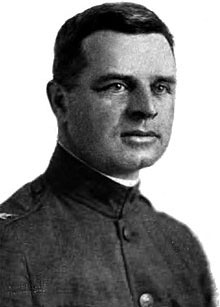 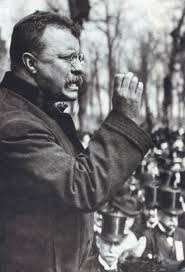 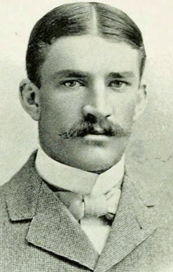 L-R: Charley Daly, Theodore Roosevelt, Paul Dashiell Among the spectators was Theodore Roosevelt, who had moved into the White House following the assassination of President McKinley in 1901. Roosevelt was an old Army man, but he rooted enthusiastically for both sides. At the 1901 game, he sat on the Navy side during the first half and then switched to Army's in the second, the start of a long-standing tradition for United States presidents. When Navy tied the score 5-5, Roosevelt was so excited he leaped out of his seat, broke clear of his security guards and made a mad dash to the Middies bench, where he slapped the players on their backs. In the 1905 game played in Princeton, New Jersey, Roosevelt once more prowled the sidelines and cheered on the teams. He became so animated at one point that his security people had to practically restrain him from running on the field. Roosevelt, a hardy outdoors type who fought in the Spanish-American War, loved football. But he didn't like what was happening to the sport, which was suddenly the center of controversy with an unusual number of deaths and injuries. In 1905, there were more than twenty football fatalities and a number of serious injuries, and many colleges had banned the sport. One player remembered how violent the game was in the early 1900s, especially for quarterbacks. "He'd have these large loops on his belt and a teammate on each side of him would hoist him up and throw him over the line," recalled Dutch Herman, who played for Penn State in the early 1900s. "They lost a lot of quarterbacks that way." Roosevelt had seen other things in the game he didn't like. Once, attending a major Eastern game, the president witnessed a player biting away a piece of an opponent's ear. Roosevelt was outraged. He considered banning the sport altogether. Instead, he invited "Skinny Paul" Dashiell, the Navy coach from 1904 to 1906, and Army captain Palmer Pierce to the White House to discuss what could be done about the increasing violence in the game. 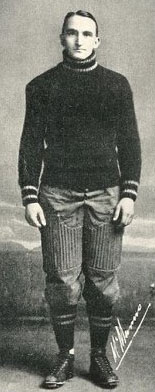 Eugene Byrne But even though the Flying Wedge was outlawed, football could still be extremely dangerous. There were "mass plays" that were offspring of the Wedge and still legal. In the 1909 season, Army met Harvard at West Point before a crowd of about 10,000. One of the onlookers was John Byrne, father of Cadet mainstay Eugene Byrne. Byrne weighed only 170 pounds, but like many of his Army teammates was a real scrapper. The Cadets at that time may have not had the biggest or most talented group of players, but they were certainly a battling group. Harvard, led by two-time all-American tackle Hamilton Fish Jr., had it all: size, strength, and talent. Fish was a specimen at six foot four, 200 pounds. The Crimson were considered the No. 2 team in the East behind only mighty Yale. At that time, being No. 2 in the East was virtually the same as being No. 2 in the country. It was a time when the Ivy League, particularly the "Big Three" of Yale, Harvard, and Princeton, ruled college football. On this fall afternoon, Harvard was cruising with a 9-0 lead late in the game. With only about 10 minutes left, Harvard called for a "mass" play—sending fullback Wayne Minot crashing through the line behind the stout interference of Fish and Robert Fisher. The play was directed at a space on the line between Byrne and Vern Purnell. The big bodies of the Harvard line cracked into the smaller Army line. Byrne, wearing the thin leather helmet of the day that offered little protection, lunged forward and then disappeared underneath a twisting mass of arms and legs. When everything cleared, both Byrne and Minot lay motionless on the ground. Byrne was one of thirty-three football-related deaths reported across the country in 1909. Army immediately canceled the last four games of the season, including the meeting with Navy. About this time, the forward pass was becoming an important part of the game. Now the ball could be thrown forward to an eligible receiver. No longer did quarterbacks have to fly through the air with the greatest of unease. Dashiell was among those chiefly responsible for the introduction of the forward pass. The new weapon was much in evidence when Dashiell's Navy team played Army in 1906. When a fumbled punt gave Navy the ball on the Army 40-yard line, Homer Norton dropped back as if to try a field goal. Instead, he lofted a pass to Jonas Ingram and the Navy receiver ran past the flabbergasted Cadets for a touchdown. With "Anchors Away" making its debut, the Middies were inspired by the rousing new school song and beat the Cadets 10-0. The Strange Saga of the Impostor Opponent
savvygameline.com February 2020
On a balmy Saturday in South Florida, fans were filing into the Orange Bowl to watch their Miami Hurricanes play another underdog opponent. It would be weeks before they would realize they had witnessed one of the most unusual games in college football history. Besides talking about the game, there was plenty of chatter about other things such as the historic performance of the Chicago Cubs in the recent World Series, America's success in the Summer Olympics, and the November 8th election which had swept a new president into office with surprising ease. The year was 1932. University of Miami records show that on December 24, 1932, its team defeated William and Mary, 6-2. What the records don't show is that Miami's opponent was an impostor. Not only were the Hurricanes playing the wrong team, but the opponent they were facing was a two year college, or in modern terms, a community college. There are two questions that come to mind at this time. How could players and coaches from a two-year college think they could take the place of the "real" opponent and get away with it? How could the folks of Miami not notice the difference? The answer to the first question is simple. As strange as it seems, the community college people didn't know they weren't supposed to be there. More about that later. As for the second, the visiting impostors had similar colors and labeling as the eximious ones from William and Mary. The odd saga began with a single piece of paper and advanced with a one-inch square worth exactly two cents. Yes—a letter and a postage stamp. Months before, the Hurricane sports department had written a letter to the Colege of William and Mary with an invitation and a contract to come to Miami and play a football game in the brand new Orange Bowl on Christmas eve. When the postman picked up the letter, all was in order. Except the mailing address. Instead of addressing the letter to William and Mary in Williamsburg, Virginia, it was sent to Norfolk. The postman in Norfolk noticed no discrepancies because William and Mary had started an extension campus in Norfolk two years before with the name William and Mary, Norfolk Division. When the football people in Norfolk received the invitation, they were as delighted as they were surprised. And why wouldn't they be? They had only started their football team a year before and had assembled it in just two days. So being recognized by a big school like Miami so soon was unexpected affirmation, enough to make their heads nod. While tugging on their suspenders and being rather taken by themselves, someone signed the contract and sent it back. When the time came, the football people in Norfolk booked a two-day train ride to Miami and entered the stadium fully believing that they belonged. They played so well that the Hurricanes chose to take a safety late in the game rather than risk a mishap punt from their own end zone. Let me anticipate your question: How could a two-year school with a one-year program possibly come to within four points of mighty Miami? Was it just a different era back then and scores like 6-2 were common? Actually—no. The scoring was similar to our modern scoring. So, there are other reasons. Yes, they sound a bit shady but at least they explain things. Not everyone at the school was surprised that the team played as well as it did. Dr. Rufus Tonelson was a student at the school in 1932 and he said that even though Norfolk Division was a two-year school and its team was new, many of its players had sketchy backgrounds and little interest in education. In other words, they were football guys. "I guess some of the boys may have been questioned as to their academic status at the time," he said. "I know that a number of them, after the football season was over, just withdrew from school." The College of William and Mary-Norfolk Division football program was terminated in 1941 when the school concluded that changes in the rules and a $10,000 debt were insurmountable impediments. It probably didn't help that the 1941 team didn't win a game. It also didn't score a point. Norfolk Division grew into a four-year university and three decades after the 1932 Orange Bowl, the Norfolk administration announced its sovereignty, a new name, and its rights to all-things Norfolk dating back to the campus' inception in 1930. The new name? Old Dominion University. Even today, the Miami University website claims that the Hurricanes played William and Mary but of course, neither William nor Mary showed up. If we wanted to correct the Hurricane website, how exactly would we do so since Norfolk Division no longer exists and the Old Dominion University didn't appear until 1962? Man of Few Words
Tales from the Gator Swamp: A Collection of the Greatest Gator Stories Ever Told, Jack Hairston
Warren Fair, a Gator letterman at guard in '57, furnished several stories for the book. One of the favorite subjects of Fair was his Gator coach, Bob Woodruff.
"He was a very intelligent person who came out with some of the damnedest things. Someone described Coach Woodruff as the oratorical equivalent of a blocked punt," Fair said. That Woodruff was capable of poking fun at himself was proved when he took that description and applied it to himself often in his talks. "A lot of people swear he made the same pep talk every game, and he did," Fair said. "Just a few words were different sometimes. I still remember his talks, especially one time when he said, 'Get out there and tackle 'em HARD and block 'em HARD, and don't forget, the team that makes the fewest mistakes always makes the fewest mistakes. ...' "We were studying film on Wednesday night before the game one week. It was pitch black dark in there, and Coach Woodruff kept running the film backward and forward. Then we all noticed a strange smell in the room. Woodruff smoked cigarettes at the time, and this deep voice of his came out of the dark, 'Lit the wrong end....'" "When we were scrimmaging, Coach Woodruff constantly would say, 'Run that play back.' One day the players prepared for him to say that after a pitchout from the quarterback to the halfback, and when he said it, the players ran the play backwards, like it would be re-run when you backed the film up. Every player ran backward from downfield back to the huddle. They even had it arranged where the running back pitched the ball forward to the quarterback, and the quarterback ran backwards to his spot under center. It broke everybody up, including the coaches." .jpg) 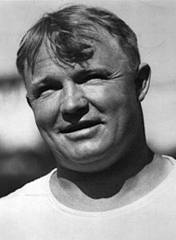 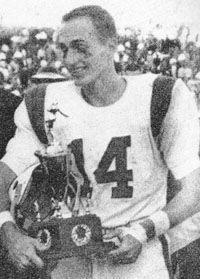 L-R: Bob Woodruff, Wally Butts, Jimmy Dunn "Georgia was already mad about the game," Fair said, "and when it was over, Coach Woodruff walked up to shake hands with Wally Butts, Georgia's coach, and said, 'How did you like our offense, Wally?'" Fists were thrown at some postgame parties because of comments like that, but Butts was able to restrain himself regarding Woodruff's comment. Dick Stratton, Jacksonville TV sports director and a UF graduate, showed up at the Green Derby restaurant in Jacksonville with the game's official statistics about an hour after the game. One of Georgia's assistant coaches was in the room as Stratton read the stats in dramatic fashion, something like this: "First downs, Georgia 18, Florida 4. Rushing yards, Georgia 280, Florida 90. Passing yards, Georgia 120, Florida 10. Total yards, Georgia 400, Florida 100. But the most important statistic of all: Points, Georgia 6, Florida 7." The Florida fans in the crowd broke into applause, but the Georgia assistant coach jumped up and decked Stratton with a right to the jaw. There's disagreement about who the Georgia assistant was, so his identity is being withhead. Just Another Game for Jim Brown
From Jim Brown: The Fierce Life of an American Hero, Mike Freeman (2006)
A scene from the life of Brown. It was October 13, 1963. As he had done so many times before, in so many different ways, Brown was demonstrating that he was a physical being who had mastered a brutal sport.
Cleveland was in Yankee Stadium playing the New York Giants. Tickets to the game were tough to get because the Browns had won their first four games, and because Jim Brown was going to be on the field. The old NFL was a different entity than the polished, image-conscious sport it has become. Then, the rules were few and the tactics cheap. Football was full of dirty players and optically challenged game officials. Punching, kicking, head slapping, biting - it all happened with disturbing regularity.
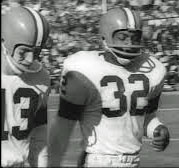 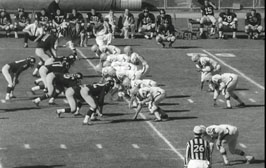 L: Brown comes off with QB Frank Ryan; R: Ryan calls signals in '63 Giants game. Brown experienced it all. As the most dangerous weapon on the Browns team, he drew the attention and the cheap shots from the most vicious enforcers. The Giants were no different. In the moments following Brown's first carry, one of the Giants defenders stuck several of his fingers inside Brown's woefully inadequate face protection. It was the NFL's long-retired two-bar face mask; the bars were several inches apart and rested just beneath his nose, offering the Giants more than enough room to attack his face.
The Giants players mostly went after Brown as he was going down to the ground. When Brown was underneath the massive piles, his arms pinned, practically defenseless, fingers jabbed and gouged and probed under Brown's face mask. As the game continued, it became clear that Brown's eyes - the sharp brown ones that allowed him to view the field with digital clarity - were under a planned, organized assault. Over the course of the first half alone, Brown's eyes would be poked or hit a half dozen times, at least, by several Giants players, often in the large pileups. In a particularly vicious moment, one of the Giants players shoved his elbow inside the mask and jammed it into Brown's left eye. When Brown arose his vision was severely blurred, as if he were trying to see through a thin, closed curtain. At halftime, Brown plodded over to a corner of the locker room and sat alone, gathering his thoughts. Brown had scored a 1-yard touchdown in the first half and Cleveland trailed only 17-14, but something was wrong with Brown. He was questioning himself. He was experiencing fear. Everything changed in the second half. Brown's fear was gone, replaced by icy anger. He took a screen pass from quarterback Frank Ryan, ran over two Giants players, and burst for a 72-yard touchdown. All of those hands and fingers and elbows that had searched for his eyes were now grasping for air. On Cleveland's next possession, there was another Brown score. The Cleveland linemen, using an option blocking system, in which Brown picked his running lanes, freed Brown for a 32-yard touchdown. By now, the Giants had ceased their cheap shots. They were too stunned and broken by Brown to do anything except relent. Cleveland was victorious by 11 points. Forty-eight hours after the game, Brown's vision was still blurry. Both of the fullback's eyes were swollen and aching. He had told no one in the media what was wrong except a reporter for Sport magazine. "It was my most satisfying game under the circumstances," Brown told the media. He declined to state just what those circumstances were. Brown had asked one of the assistant coaches about going to a doctor but was told to wait until after practice. If his teammates became aware he was hurt, it could demoralize them. So Brown told only a few close friends on the team and one sports reporter, and swore them to secrecy. His eyes throbbing through drill after drill, Brown waited until practice concluded, then quietly went to see a physician later that night.
Greene Wasn't Always Mean Joe
Hell with the Lid Off: Inside the Fierce Rivalry between the 1970s Oakland Raiders
and Pittsburgh Steelers, Ed Gruver and Jim Campbell (2019) He never thought he deserved to be called "Mean." The nickname came into vogue during Joe Greene's sophomore year at North Texas State. The team wore green, and because Greene and the defense was playing well they were called the Mean Green. Joe being named Greene, the moniker rubbed off on him.
When he signed autographs in his early years with the Steelers, the future Pro Football Hall of Fame DT would sign Joe Greene, leaving off the Mean. The way Greene saw it, he did the best he could on every down and played hard on every play. "But," he would quickly add, "I'm not mean." Sometimes he talked to opposing QBs when he got to them during games, but it was never mean. "Don't bother to run the draw," Greene would tell the flustered QB, "because I'm going to be sitting right there in the hole waiting for it." Greene respected offensive linemen but never believed any of them should ever beat a defensive lineman man on man. Some offensive linemen sought to beat their defensive counterparts with quickness, some with strength. Greene never studied the man who would be opposite him. The leader of the Steel Curtain defense would wait to see what his opponent was trying to do when the game started, and Greene would react. "I do what I have to do," he would say. Steelers offensive linemen found this out firsthand in team scrimmages. After being the first pick in new head coach Chuck Noll's first draft in 1969, Greene held out before signing. He was considered the cornerstone for what the Steelers were trying to build, and the contract holdout angered some of the team's veterans. C Ray Mansfield and G Bruce Van Dyke looked forward to teaching the rookie a lesson or two. A couple of days of dealing with Greene in practice left Mansfield and Van Dyke wishing they'd never met Mean Joe. ... Greene wasn't always devoted to football. Growing up in Temple, Texas, he quit the sport the first time he tried out for it in the eighth grade because they didn't give him a full uniform. Greene gained confidence in his ability as a 203-pound high school freshman. By his sophomore year he was a 235-pound MLB. He weighed 250 his senior season, and his reputation was just as outsize. 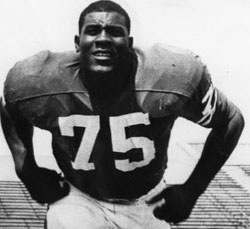 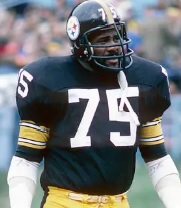 L-R: Joe Greene at North Texas State and with the Steelers Greene took out his aggressions on the football field. He got the reputation of being a bully. Greene knew he wasn't; he was exacting revenge for being teased. He once recalled being kicked out of every game his sophomore season and nine more his junior year. He ran over a few officials, sometimes intentionally, he said. Following a loss on his high school's home field, Greene went to a diner and encountered the team that had won. The opposing QB was enjoying an ice cream cone. Greene took the cone and smeared it all over the QB's face. Later that night he charged the front door of the opposing team's bus after being hit in the chest with a soda bottle thrown by one of the players. As Greene forced his way in through the front door, opposing players scampered out the back. ... The same lack of discipline was evident to scouts who visited North Texas State. "Puts on weight, tendency to loaf," one scout said. Another opined that while Greene was physically gifted, he used his ability only in spurts. The final line in the Steelers' 1969 scouting file on Greene questioned taking him in the first round, "as he could turn out to be a big dog." Greene instead became the Steelers' top dog, the cornerstone of one of sports' greatest dynasties. Opponents saw him as mean, nasty, and intimidating - a big man who threw his weight around fiercely. Sometimes he could be reckless and take himself out of plays. But Greene also made tremendous plays that turned games around. He was inconsistent at times, given to playing some ordinary games. But Greene's ordinary games were better than outstanding games by other players. Mean Joe was one of the few defensive linemen who could dominate for four quarters. He was a powerful player on a powerhouse team, and he was always up for the big games. "Greene," George Allen said, "was the one who scared you the most." Greene's coach at North Texas State called his defensive star a "fort on foot." In Pittsburgh the fort fronted what became known as the Steel Curtain. Greene had all the physical tools to be successful in the NFL. He also had vision, a quality he considered more valuable than all the others. He could see what was happening on every play, could see where the blocks were coming from and where the ball was going. His biggest handicap was his tendency to guess. Early in his pro career Greene said that when he got into the game, he didn't always have time to think about what he ought to be doing. Monty Stickles, ... a Raiders color analyst ..., noted during a Steelers-Raiders game that while Greene was a very active tackle, his aggressive style sometimes took him out of the play. Greene credits Noll for curing him of his tendency to play a guessing game with opposing offenses. When Greene guessed right he turned into a tornado that tore up everything in his path. Noll convinced Greene that guesswork meant he would be right only half the time. Do the job you're supposed to, Noll told him, and let his teammates do their jobs. When they didn't Greene let them hear it. Russell recalled Greene growing angry when an opponent had success against the Steelers' defense. "Andy," Greene thundered, "what're you going to do?" Greene got just as excited on the sidelines. He would approach Noll and say, "What's the QB doing?" and then approach WR coach Lionel Taylor and say, "What're the receivers doing?" Russell said Greene was such a great player that he thought everyone could play better if they only tried harder. Greene pulled himself from a game in '73 and stalked out of a team meeting in '74, upset with what he saw as his teammates' lack of fervor. Merger Problems
America's Game: The Epic Story of How Pro Football Captured a Nation,
Michael MacCambridge (2004) The NFL and AFL had finally agreed to merge.
There was one more matter left to be dealt with, and that was the task of convincing [New York] Representative Emanuel Celler and the House Judiciary Committee to approve the merger. As the fall wore on and the owners grew increasingly alarmed, it became clear that Celler had no intention of letting the legislation pass. At a hearing in the Rayburn House Office Building on October 11, 1966, Celler upbraided Rozelle ..., refusing to let the bill out of committee.
Rozelle, seeking a way to break the logjam, called his friend David Dixon to see if he knew a North Louisiana congressman on the committee. "For someone as sophisticated as Pete, he was rather naive when it came to politics," said Dixon. "The idea that any congressman from Louisiana was going to be able to change Emanuel Celler's mind about anything was ludicrous."Dixon had a better idea. House Majority Leader Hale Boggs, who'd been a fraternity brother of Dixon's at Tulane, was seeking to regain some popularity after his vote in support of the civil rights bill caused his electoral majority to drop from 67 percent to 55 percent. Dixon sent his political adviser, David Kleck, up to Washington the next day, to impress upon the patrician Boggs, no sports fan, that it would help his cause to push the bill through, especially since doing so would virtually guarantee an NFL franchise in New Orleans. The NFL had been eying New Orleans for its next franchise anyway. So a thinly veiled quid pro quo was offered - a franchise for New Orleans in exchange for the exemption [from the anti-trust laws] - and Boggs went into action, circumventing Celler by attaching S. 3817 to a budget bill sure to pass in both houses. The final approval would come October 21. Walking up the stairs of the Rotunda, when the vote looked like a sure thing, Rozelle was his usual humble self. "Congressman Boggs, I don't know how I can ever thank you enough for this. This is a terrific thing you've done." Boggs had been a veteran of Louisiana too long to let such transparent politesse go unremarked. "What do you mean you don't know how to thank me?" he said. "New Orleans gets an immediate franchise in the NFL." "I'm going to do everything I can to make that happen," Rozelle assured him. At that, Boggs stopped and turned on his heels, heading back to the committee room. "Well, we can always call off the vote while you -" Rozelle took two giant strides after Boggs, turned him gently around and said, "It's a deal, Congressman. You'll get your franchise." "If this doesn't work out," said the patrician Boggs, by now perturbed, "you will regret this for the rest of your fucking life." It worked out, signed by another presidential football fan, Lyndon Baines Johnson, who'd taken to ordering highlight reels from NFL Films sent to the movie theater at the White House. The NFL and AFL got their merger and, a week later, New Orleans got its NFL franchise. 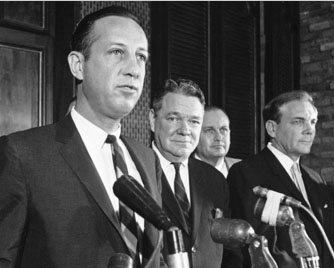 Pete Rozelle announces the awarding of an NFL franchise to New Orleans with Congressman Hale Boggs to his left and Governor John McKeithen at far right. Lynn Swann - Tougher than You Think
Hell with the Lid Off: Inside the Fierce Rivalry between the 1970s Oakland Raiders
and Pittsburgh Steelers, Ed Gruver and Jim Campbell (2019) The 5-foot-10, 178-pound Swann shared similarities with [Steelers LB Jack] Lambert in that both were undersize for their positions. But where Lambert was rough and rugged, Swann was as smooth and graceful as his surname suggests. As an eleven-year-old Little Leaguer, Swann made a seemingly impossible leap at the outfield fence to snag in the tip of his glove a ball that had already cleared the wall. The catch preserved a win for Swann's team, the Senators. It was the kind of levitating leap Lynn became famous for during his Hall of Fame career with the Steelers, most notably at the end of the '75 season. "Lynn Swann," [Steeler coach Chuck] Noll would say, "has a sixth sense to go fro the football and catch it."
Swann's acrobatic catches, his ability to twist his body into S curves at the height of his leap, could be traced to his mother's insistence that his childhood be about more than sports. Born in Alcoa, Tennessee, Swann grew up in the San Francisco suburb of Foster City. His father worked the night shift at the nearby airport, and Lynn's mother spent nights giving him Bible lessons. He ... took tap-dance lessons and ballet classes in order to appreciate the arts. Swann became a regular visitor to art galleries, ballet recitals, museums, and the theater. Each time Swann soared to make a catch, his years of ballet training and long jumping were in evidence. In high school he claimed the California state championship with a long-jump distance of 25-41/2. Some speculate that Swann could have been an Olympian in track and field. But football proved to be Swann's primary sport. He earned a scholarship to a private Catholic school, Serra. His brother, Calvin, older by a year, attended a public school, San Mateo High. In 1968 a football game between the two schools was billed as a grudge match between the Brothers Swann. The disputes at home the week of the game became so contentious Lynn moved in with his coach in the days leading up to kickoff. Both of the brothers played well, catching two touchdown passes apiece, and Serra won 57-33. 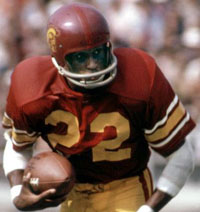 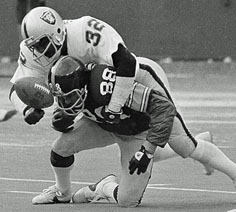 Lynn Swann at USC; Jack Tatum hits Swann As a rookie with the Steelers he led the league in punt-return yardage and by season's end was sharing playing time with Ron Shanklin. Because Pittsburgh's offense was run oriented in 1974, Swann had just eleven catches for two TDs in the twelve games he played. Still, the Steelers' brass saw so much in Swann, they dealt Shanklin to Detroit prior to the start of the '75 season. Pittsburgh receivers coach Lionel Taylor, a former AFL star, had a way of testing a player's concentration and reflexes. Taylor would hold a small tube and in the course of a conversation with the player drop the tube. Most players would make a desperate grab but miss catching the tube. Swann snagged it virtually every time. Swann, however, very nearly didn't make it through the '74 season. A light snow was falling on Pittsburgh in the early-morning hours following the Steelers' Monday-night game in New Orleans. The snow turned to ice, and Swann, driving Franco Harris home from the stadium, hit an ice patch and slid down a hill. Swann recalled doing the worst thing he could do - hitting the brakes. Swann's car didn't stop skidding until it was within inches of the guardrail. "I thought I was going to kill Franco and myself," Swann said. Firmly entrenched as a starter in '75, Swann did not disappoint. Despite drawing double coverage on a consistent basis, Swann caught 49 passes for an AFC-best eleven TDs and earned the respect of CBs around the NFL. Willie Alexander of the division-rival Houston Oilers said Swann wasn't the swiftest receiver in the league and didn't own Isaac Curtis-style speed. "But," Alexander added, Swann "always gets to the ball." Swann got the ball often enough to help Pittsburgh post a 12-2 record that was a team-best mark to that point. Steeler fans bedecked Three Rivers Stadium with banners praising the young star who wore No. 88: "Swannie, How we love ya!" Additional banners cited a new math for the Steel City masses when it came time to totaling up the big-play Bradshaw-to-Swann connections: "12 + 88 = 6!" One of Swann's leading tormentors, Jack Tatum, considered Swann a superb athlete. He admired Swann's grace, quickness, and speed as well as the fact that Lynn could catch the ball like few, if any, receivers could. Tatum played against several Hall of Fame receivers, including Paul Warfield, whom Tatum held in the highest esteem. Tatum credited Swann for understanding that self-preservation is an important part of football. Tatum said he practiced it himself when it came to confronting Earl Campbell and Larry Csonka in the open field. When Oakland played Pittsburgh in the rivalry years, Tatum said the Raiders' defensive focus was more on flanker John Stallworth. The reason was that Oakland's Soul Patrol saw Stallworth as a receiver more likely to stick his nose into the action. Swann and Stallworth played together for nine seasons and soared to rarefied heights reserved for only the greatest receiving duos ... Because Pittsburgh was primarily a power running team for the first four years of their careers, Swann and Stallworth's numbers aren't as impressive as later duos like Buffalo's "K-Gun" combo of Andre Reed and James Lofton, Minnesota's Randy Moss and Cris Carter, or the tandem of Torry Holt and Isaac Bruce on the St. Louis Rams' "Greatest Show on Turf." ... Swann became the Baryshnikov of the NFL. He also became the target for the rival Raiders. When Tatum and George Atkinson learned of Swann's studying ballet and dance, they believed he could be intimidated. "They went after him," Raiders LB Phil Villapiano said. The Steelers saw what Tatum and Atkinson were doing, but Stallworth said there was never a point where Pittsburgh believed that Swann was intimidated. "The Raiders thought they could intimidate Lynn by hitting him," Stallworth said. "I never saw him not jump or not reach as high as he could to catch the football. So if that was their strategy, it didn't work." Still, Swann added, it didn't stop the Raiders from trying. "I ain't got no comment."
Heart Stoppers and Hail Marys: The Greatest College Football Finishes (Since 1970),
Ted Mandell (2006) Fran Curci was not a crowd favorite at Tulane. And with good reason.
In 1972, Curci, in his second year as head coach at Miami, led his Hurricanes into battle against the Green Wave at the Orange Bowl. With Tulane leading 21-17 late in the fourth quarter, Miami drove to the TU 18. The following sequence of plays occurred. First-and-10 at the 18. Chuck Foreman gains 2y. Second-and-eight at the 16. Ed Carney throws incomplete, intended for Foreman. Third-and-eight at the 16. Carney's pass to Foreman is complete but Miami is penalized for illegal procedure. After the penalty, third-and-13 at the 21. Carney's sacked for an 11y loss. Fourth-and-24 at the 32. Carney throws incomplete to Phil Corrigan. Tulane takes over on downs, right? Wrong. Miami was mistakenly given an extra down. Fifth-and-24 at the 32. Carney hits Witt Beckman for a 32y TD pass with 1:05 to play. Miami, benefiting from an official's mistake, shocked the Green Wave and won 24-21. Tulane president Dr. Herbert Longnecker meticulously articulated the opinion of his school. "Had Tulane won a game under these conditions, the alleged victory would have been rescinded by our own actions and the game's outcome would have been reversed with the score reverting to that existing at the time of the illegal play," he said. The rest of the Tulane faithful were more succinct. "We got screwed," was probably the prevailing response in New Orleans. Either way, Miami kept the victory and Tulane kept a chip on their shoulder for Curci, who the following year, took the head coaching position at Kentucky. Eight years later, Curci brought his Wildcats to the New Orleans Superdome on All Saints Day to face Tulane, a school that was seemingly cursed against Curci-coached squads (Tampa, Miami, and Kentucky) ... winless in five tries. But this time, the Green Wave looked golden against Kentucky. Led by the combination of senior QB Nickie Hall and senior WR Marcus Anderson, Tulane jumped out to a 21-3 second quarter lead. ... Then something came over the Green Wave. They blew a huge opportunity. After Tulane's Lionel Washington intercepted UK QB Larry McCrimmon and returned the ball to the UK six, the Green Wave looking to blow the game open, failed to score. First-year coach Vince Gibson skipped a sure FG attempt, only to fall short on fourth down, turning the ball over to the Wildcats shy of the goal line. Curci's 'Cats responded with a 35y FG as the first half expired making the score 21-6. 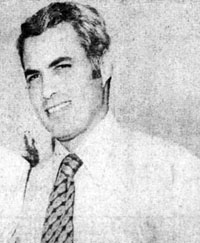 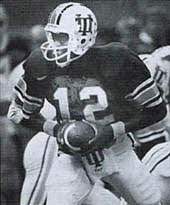 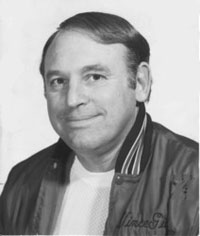 L-R: Fran Curci, Nickie Hall, Vince Gibson Still, the Tulane offense struggled, forced to give up the ball as time ticked away. The Wildcats ran the clock down, then punted, pinning the Green Wave back to their 8y line with just 0:12 on the clock. There were no plays in the Tulane playbook designed to gain 92y in 12 seconds. So Hall just dropped back into the end zone and launched a long prayer toward Anderson across midfield. "They were playing a prevent defense," said Hall. "Coach told me, 'Let Marcus run across the field,' and I told him I'd throw it as far as I can." Hall heaved it. Anderson reached for it. The ball fell incomplete. Seconds later, a flag fell. DB Chris Jacobs was called for pass interference on Anderson, a spot infraction at the time, translating into a whopping 46y penalty against the Wildcats. Now five seconds remained on the clock. The ball was placed at the UK 46. Tulane had one more chance. Or did they? Tulane used their final timeout. Then Hall tried Anderson again, hoping for a miracle at the end of another Hail Mary pass. He didn't get a miracle. He got another flag. Pass interference again on Kentucky. This time, DB Venus Meaux had been singled out, making contact with Anderson before the ball arrived at the 4y line. A 42y penalty. Tulane had been mystically swept from their 8y line to the UK four on a magic yellow carpet ride. The clock read 0:00. Since the game cannot end on a defensive penalty, Tulane was given one extra play. Beside himself on the sideline, Curci knew what one extra play can mean. Perhaps this was his penance, eight years removed. Tulane kicker Vince Manalla came on to attempt a 19y FG with no time on the clock. It was the football equivalent of a technical foul in basketball. Manalla made it. Tulane won 24-22. The Wildcats felt cheated. "It's all that fifth down stuff," said UK reserve HB Terry Henry. "No wonder Tulane is 6-2 (actually 6-3)," added disgruntled RB Richard Abraham.Curci was too mad to talk. "Gentlemen, I ain't got no comment," he muttered to the media before slamming the door behind him. His team was penalized 169y for the game. Call it redemption. Call it righting a past wrong. But at Tulane, they call it the "Miracle of All-Saints Day." Three...Two...WON!
Super Bowl XLVIII Game Program (2014)
In the Super Bowl's formative years, there were only a handful of truly tight contests ... Then it all changed ... 25 years ago.
The start of this Super Bowl thrill ride came in the midst of the 49ers dynasty: Super Bowl XXIII against the Bengals at Miami's Joe Robbie Stadium. Favored to return to the Bay Area with the Lombardi Trophy in tow, San Francisco instead trailed, 16-13, with just 3:20 to play and the ball resting at its own 8y line. It was desperation time, and when QB Joe Montana entered the 49ers huddle to start what has become the most famous drive in Super Bowl history, he sensed that his teammates were nervous, most noticeably OT Harris Barton. Montana needed something to ease the tension. Looking into the stands, he spotted a recognizable face, the late actor John Candy. "Look, isn't that John Candy?" Montana said to Barton. That comment was not something Montana's teammates expected. A few of them chuckled; they all relaxed. 92y later, San Francisco won its third Super Bowl in eight years. "Any time Joe had the ball in his hands and the game was close, we figured we'd win," says Hall of Fame receiver Jerry Rice, who was then in his fourth pro season. "We all bought into that. Great players feel pressure, but we live for that. It's like Michael Jordan taking that final shot. If you miss it, you have to deal with the criticism. But Joe wanted the ball in his hands. "Every Thursday, all year long, we worked on the two-minute drill at the end of practice when we were tired. This is why we did it. I heard Joe say something to Harris Barton, but the second the huddle broke, I didn't hear anything - no crowd noise, nothing. I was in the zone." 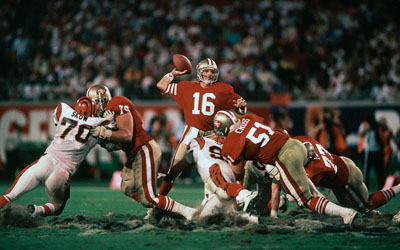 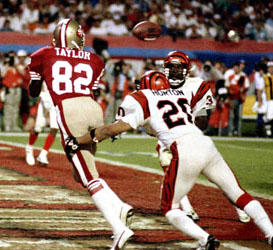 L-R: Joe Montana passes on final drive; John Taylor catches the winning pass. Rice made three catches during the drive, including a 27-yarder over the middle that he nearly broke for a touchdown. It was a tremendous play by both Montana and Rice, coming on a second-and-20. Not only did Rice snare a pinpoint pass at Cincinnati's 33y line, he somehow eluded three Bengals defenders who had converged on him. He picked up another 15y and believes he would have made it to the end zone if fellow receiver John Taylor hadn't missed a block.
"Normally John makes that block," says Rice with a laugh. "If he does, I score." Taylor soon atoned for the miscue. The 49ers are now deep in Bengals territory, with plenty of ammunition. They had Montana. They had Rice. And they had Hall of Fame head coach Bill Walsh, whose play-calling was always one step ahead of the opposition. "The Bengals all expected the ball to come to me [again]," Rice says. "But Bill Walsh was that genius. He called a play for John Taylor." Montana hit Taylor for the winning touchdown with 39 seconds left on the clock. It was Taylor's lone reception of the game. Rice, meanwhile, was named Super Bowl MVP for a remarkable performance - 11 catches for 215y and a touchdown - in his team's 20-16 triumph. Rice recalls his relief when Taylor caught the decisive touchdown. "I've got to be honest, winning my two other Super Bowls (XXIV and XXIX) by blowouts was a lot easier," he says. "But when you win the Super Bowl in a great game like that, you just feel fortunate. Nobody remembers the Super Bowl loser. They only remember the winner. Thanks to that drive, it was us." The Unlikely Showman
Aditi Kinkhabwala, Super Bowl LIII Game Program (2019)
The 1999 Super Bowl shined the spotlight on Kurt Warner's amazing journey from bagging groceries to being a Super Bowl hero - and all the stops in between. Now that nearly two decades have gone by, now that the 1999 Rams team is officially cemented as one of history's most dynamic - fantastic moniker and all - and now that Kurt Warner is forever enshrined in the Pro Football Hall of Fame, London Fletcher has no problem telling the truth.
When Rams head coach Dick Vermeil sat forward in his chair that day in August, when he tearily talked about starting QB Trent Green's devastating injury and promised the world, "We will rally around Kurt Warner and we will play good football," he didn't have many buyers. "I'm not sure," Fletcher says, "any of us really believed him." Fletcher, the team's starting MLB, then laughed. Because these days, there are all sorts of folks saying they foresaw Warner's greatness. And every single one of them, Fletcher insists, "is lying." As the Super Bowl returns to Atlanta, it comes back to the scene of perhaps the most unexpected, and most magical, of football fairy tales. Before the 1999 season, Kurt Warner was a 28-year-old unknown never-had-been whose biggest body of work came in the Arena League and whose sum total of NFL experience was 39 passing yards. But by the end of that season, when Vermeil, Fletcher, and the rest of the St. Louis Rams hoisted the Lombardi Trophy high above their heads at the Georgia Dome, it was because they'd been buoyed by the arm of Warner. Some might call it "kismet." "Without question, I hit the perfect storm," Warner says, still marveling a bit, all these years later, at the way the football fates lined up. "I'm not going to sit here and tell you I thought it would work out the way it did." Warner was supposed to be the Rams' backup QB in 1999, moving up one slot on the depth chart after being the third-stringer the year before. That he'd even made the team - or was in the NFL - was a story in itself. He'd started exactly one year at Division I-AA Northern Iowa. He was his conference's Offensive Player of the Year but then went undrafted, and though the Green Bay Packers brought him to training camp in 1994, they cut him before the regular season even started. ... Though he had a strong arm and deceiving athleticism, Warner wasn't particularly seasoned, and so after a year stocking a grocer's shelves for $5.50 an hour, his next opportunity came with the Iowa Barnstormers of the Arena Football League. In 1996 and 1997, he played in the Arena League's title game and earned All-Arena honors. After the 1996 season, the Chicago Bears called, offering him a tryout. He accepted the date and then had to cancel, forgetting that he was getting married on the same day. The Bears gave him a second date, but he got stung by something while on his honeymoon, ran a fever, and had his elbow swell up, and when he tried to postpone again, well, "They never called again," Warner says. ... After that 1997 season, the Rams signed Warner to a Futures contract and sent him off to the Amsterdam Admirals of NFL Europe. He played well enough that the Rams kept him stateside in 1998. He ran the scout team and, sure, he'd on occasion shred the Rams' stout defense. But he wasn't getting hit, and he admits never being as good a practice player as he was under the lights of game day. So when the 1999 expansion draft came and every NFL team had to expose five players, Warner was among those St. Louis left unprotected. Once the (new) Cleveland Browns passed him by, the Rams knew they'd have him back, yet they still went out and signed Trent Green, who had spent the previous four seasons with the Redskins. Warner went back over all that and then chuckles, "Trent was what gave us hope!"  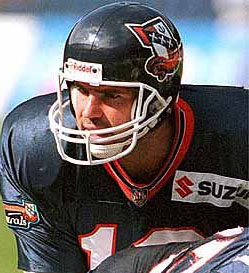 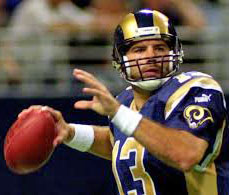 L-R: Kurt Warner in Arena Football, NFL Europe, and the Rams "Mike would just destroy him. But we all knew what he was doing. Kurt would study and draw, study and draw. He obviously put in the work," Green says. "The thought process was I wasn't going to get hurt and Kurt was going to have time to develop." Green did, of course, get hurt, tearing his ACL in the team's third preseason game. Green remembers discussions of the Rams trying to talk Jeff Hostetler out of retirement, but even through his own disappointment, he also remembers telling part-owner Stan Kroenke, "If Kurt goes out there and has some early success, it's just going to snowball. "I thought he had potential. He needed experience," Green says. Warner got a small dose of experience in the fourth preseason game; then, in the regular-season opener against the Ravens, he threw for 284y and three TDs in a 27-10 win. And, sure enough, the snowball started to roll. Lopsided victories over Atlanta and Cincinnati followed, then came a 42-20 drubbing of the 49ers, a team that had beaten the Rams 17 consecutive times before that game. It was during that week when Warner felt a change in the team. "The way we came out and just dominated that game early on, we all started believing he had something," Warner says. "And "someone," Fletcher adds. "The thing that jumped out at me was Kurt's toughness in the pocket," Fletcher says. "That game, the 49ers came at him. There were times he knew he was about to get hit, and he just would not flinch. He wasn't out there chucking and ducking." Each week, Warner found more admirers. He was ridiculously accurate, especially under pressure. He could release the ball a millisecond before the rush arrived, he saw the entire field, and he used every piece of what would prove to be an incredibly talented roster. Looking back now, Warner believes he was uniquely prepared for his opportunity. The stints in the Arena League and NFL Europe gave him more snaps, he said, "than probably any backup in history." And then there was the style o those two leagues; in Arena football, the goal was to put up 50 points every game. "My mindset was different from guys who play real football. In real football, you score 28 points, and that's a great game. Where I came from, if we punted twice, I was mad," Warner says. "I'm asked a lot if I had the skills for arena football before or if I learned them there? I don't know the answer to that. But I know those skills became my greatest strengths in the NFL." Fletcher says Warner didn't change in any discernible way as the season went on ... and the Rams racked up wins. ... 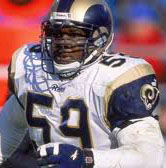 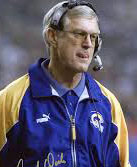 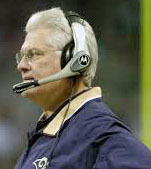 L-R: London Fletcher, Dick Vermeil, Mike Martz Warner also had an attacking play-caller in Martz, a man who had designed a truly innovative offense that would ultimately set NFL records for scoring and yardage. "The beautiful thing is that what we did offensively was just a perfect fit for me. It was designed around things I did well," Warner says. "The throws they were asking me to make were right in my wheelhouse. And to the coaching staff's credit, even after Trent's injury, we still came out and did what we'd been doing before: We threw first." And in Vermeil, Warner had a coach who truly ran a meritocracy. It was universally expected that without a strong year, Vermeil would be out of a job at season's end. Still, he trusted his own eyes and not, as Fletcher put it, "the press clippings on somebody." ... Warner says he loves to joke that Vermeil's famous tears that 1999 preseason were "not for Trent's injury, but because they were stuck with me." But in the same breath, he adds, "Coach Vermeil believed in me. I'm a very realistic guy and I can see the big picture. It would have been very reasonable for him to say, 'I don't know if we can go down with this guy no one knows about.'" By the time the 1999 playoffs rolled around, everyone in the football world knew about Kurt Warner and the Rams. They were undefeated at home, owned a conference-best 13-3 overall record, and their 526 points were 83 more than any other team. They beat the Vikings, 49-37, in the Divisional round and then their defense paced them to an 11-6 win over the Buccaneers in the NFC Championship Game. Against the Titans in the Super Bowl, the Rams racked up yards early, as they always did, but couldn't punch the ball into the end zone. They held just a 9-0 halftime lead. In the third quarter, Warner hit Holt for the game's first TD - but then Tennessee came roaring back, scoring 16 straight points to knot the game with just 2:12 to play. It was then that Vermeil grabbed Warner and told him that this would go as it always had when he was a big-dreaming kid playing in his yard. And it did. On the first play of the Rams' ensuing drive, Warner hit Bruce in stride at the Titans 38. The receiver raced for the go-ahead TD, and although there was eventually a game-saving tackle from Rams LB Mike Jones to secure the win, that Super Bowl and that season are forever branded as the "Year of Kurt Warner." ... The Best Manning of All?
"The Next Manning," Ross Dellinger, Sports Illustrated, February 2020
Nelson Stewart had it planned perfectly or so he thought. A few plays into his team's spring game last May, the coach slipped in his eighth-grade quarterback, hoping no one would notice. Stewart soon learned just how long he could keep the latest member of the sport's most fabled family under wraps. On his very first play Arch Manning audibled at the line of scrimmage, took the snap out of the shotgun and then floated a 25y touchdown pass into his receiver's outstretched hands, video of which garnered more than 2 million views on ESPN's social media platforms. So much for no one noticing. "As soon as he dropped back and threw it, I knew it would exceed expectations," Stewart says. "It was crazy. That's foreshadowing." Arch is really good at throwing a football, which shouldn't be much of a surprise. He is the namesake of grandfather Archie, a college All-American and the Saints' star quarterback for a decade; the son to Archie and Olivia's oldest child, Cooper, a former Ole Miss signee; and the nephew of Peyton and Eli, future Hall of Famers who have each piloted teams to two Super Bowl victories. Dozens of college coaches showed up last spring to watch Arch practice. As a 15-year-old freshman he threw for 34 touchdowns during the regular season, more than any QB in the football hub that is the New Orleans metro area. Random men approached him before games for pictures. Two posed as working photographers just to share a sideline with Arch. They were escorted off the field. Arch has the rich stats, the regal last name and the right build - he's already 6'2", 170 pounds - to be one of the most coveted prospects in the 2023 recruiting class. Yet he has zero scholarship offers. The reason? His family has declined them.  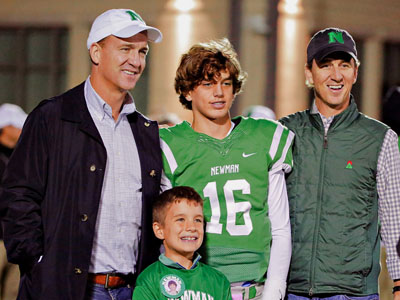 L-R: Arch Manning; Peyton, Arch, and Cooper Manning Archibald Charles Manning is the fourth member of the family to play football for Newman. You don't have to remind him. A retired jersey representing his father and two uncles hangs outside the team's fieldhouse. He lines up for home games within a sports complex that bears his surname. The school's highest athletic honor is called the Manning Award. Arch occupies the position that his grandfather played with guts and flair, one that also helped make Peyton and Eli No. 1 picks in the NFL draft. Yet neither of Arch's fabled uncles started until their sophomore seasons at Newman. After coach Joe Chango watched Arch complete 19 of 27 passes for 203y and two touchdowns against his Country Day School team this fall, he recalls telling Archie on the field, "That dude is going to be better than any one of your sons." Arch led the Greenies to a 9-2 record, completing 64.5% of his throws with just six interceptions, and surpassed 200y in all but three games. He can dance in the pocket, cycle through his progressions and spin the ball like an old pro. Arch is a "slam dunk for the future," says Frank Monica, whose St. Charles team beat Newman last season. "His release is so pure, you marvel at the fact that he's just 15." ... "When it's all said and done, he's going to be the most highly recruited player out of the state of Louisiana," says Mike Detillier, a longtime NFL draft analyst based in New Orleans. "It's going to be a tsunami of recruiting like we've never seen." For now, though, there isn't a ripple in sight. In an ear of attention-seeking recruits and spotlight-craving parents, the Manning camp has gone dark. Coaches interested in extending a scholarship have been politely told not to bother. "We just say, 'There's no offer to give because there's no offer to receive,'" says Stewart, 42, in his 14th year as Newman's coach and a teammate of Cooper's and Peyton's in the 1990s. Arch is not on social media, and he's never done an interview. Except for a few benign comments, the usually accessible Mannings declined to speak about Arch for this story or to make him available. "They're very private and protective of Arch," says John Georges, a New Orleans businessman who owns the state's two largest newspapers. "As much as they try to keep a lid on it, there's a buzz. Certain people know how to raise thoroughbreds. The Mannings know how to raise athletes." |